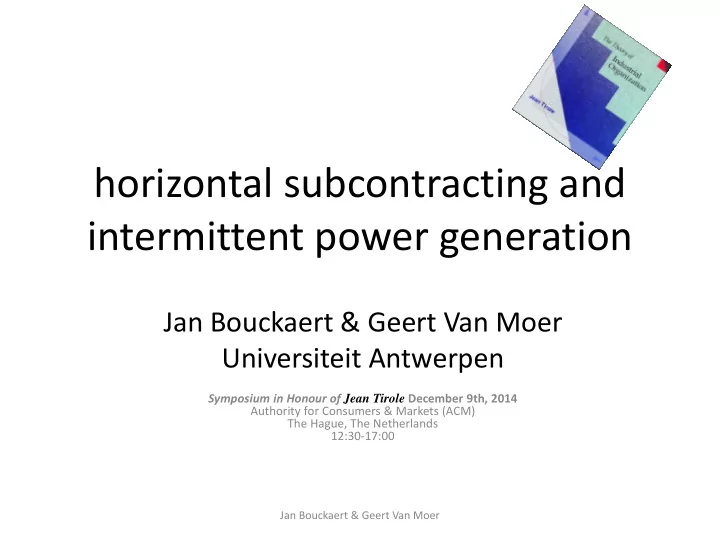

horizontal subcontracting and intermittent power generation Jan Bouckaert & Geert Van Moer Universiteit Antwerpen Symposium in Honour of Jean Tirole December 9th, 2014 Authority for Consumers & Markets (ACM) The Hague, The Netherlands 12:30-17:00 Jan Bouckaert & Geert Van Moer
intermittent energy sources • increase the need for flexible back-up capacity • reduce the #hours of operation of conventional capacity • decrease their plant profitability Jan Bouckaert & Geert Van Moer
examples • 1 MW of wind power removes only 0.2-0.3 MW of reliable energy sources (US) Jan Bouckaert & Geert Van Moer
examples • 1 MW of wind power removes only 0.2-0.3 MW of reliable energy sources (US) • capacity factors (Spain) 0,6 0,5 0,4 CCGT 0,3 fuel + gas 0,2 0,1 0 (www.ree.es) 2004 2005 2006 2007 2008 2009 2010 2011 2012 2013 Jan Bouckaert & Geert Van Moer
reliable and intermittent sources firm 𝑗 firm 𝑘 Jan Bouckaert & Geert Van Moer
reliable and intermittent sources firm 𝑗 firm 𝑘 Jan Bouckaert & Geert Van Moer
horizontal subcontracts! subcontract firm 𝑗 firm 𝑘 firms gain from outsourcing conventional generation to the wind-abundant rival Jan Bouckaert & Geert Van Moer
what’s new? • literature : Kamien et al. (1989), Spiegel (1993) – gains from subcontracting – the subcontracting terms alter equilibrium behavior subcontracting literature : • state-contingent option contracts • consumer welfare: Cournot can outperform Bertrand power markets literature : • plant profitability underestimates firms ’ willingness to invest: conventional plants need not be used to maximize profits Jan Bouckaert & Geert Van Moer
plan of the talk • general set-up – conventional plants and plant profitability • analysis – equilibrium – welfare • the option contract – competition – collusion • discussion & robustness • conclusions Jan Bouckaert & Geert Van Moer
the model • symmetric duopoly • two production technologies – intermittent, zero marginal cost – expensive back-up: 2 0.5 TC q • two-stage game – stage 1: competition for customers market demand Q 1 p – stage 2: subcontracting Jan Bouckaert & Geert Van Moer
stage 2: nature reveals state • prob. wind-abundant f irm-intermittency • prob. both firms have identical generation conditions system intermittency Jan Bouckaert & Geert Van Moer
stage 2: gains from subcontracting • efficient subcontracts • seller appropriates share of the gains σ 0 1 from subcontracting Jan Bouckaert & Geert Van Moer
back-up cost parameter • determines generation costs if ( , ) w w • determines gains from subcontracting => installing back-up • limits the price paid for subcontracting • is profitable, even if never used Jan Bouckaert & Geert Van Moer
Link with Tirole ’s work • Maskin- Tirole (1988, Econometrica ): unused capacity as a retaliatory weapon “[ firms] accumulate capacities above the level necessary to supply half the market at the monopoly price, and yet charge the monopoly price forever. That is, the firms accumulate capacities that they never use simply to make undercutting less attractive for their rivals. ” We add: idle capacity limits the “hold - up” problem. Jan Bouckaert & Geert Van Moer
Link with Tirole ’s work • Laffont-Rey- Tirole (1998, RAND ): “ bill-and- keep” vs. usage charge “[A] “ bill-and- keep” system in which networks do not pay each other access charges is not equivalent since a network’s incentive to raise price is affected by the existence of a positive access charge. ” We uncover: same logic applies in power market. Jan Bouckaert & Geert Van Moer
Bertrand: ‘s profit function i • if sets the lowest price i – customer revenues - costs no subcontracting 1 1 ( ) p p TC Q p i i i – appropriated gains from subcontracting 1- 1 2 σ 1 ( ) 0.5 ( ) TC Q p TC Q p i i 2 2 expected gains from subcontracting Jan Bouckaert & Geert Van Moer
Bertrand: ‘s profit function i • If rival sets the lowest price j – customer revenues - costs no subcontracting 0 – appropriated gains from subcontracting 1- 1 2 σ ( ) 0.5 ( ) TC Q p TC Q p j j 2 2 Jan Bouckaert & Geert Van Moer
subcontracting revenues Jan Bouckaert & Geert Van Moer
* Bertrand-equilibrium price p σ • increases in – subcontracting costs go up – high-price firm boosts subcontracting revenues • can result in less competition compared to Cournot outcome Jan Bouckaert & Geert Van Moer
consumer surplus Jan Bouckaert & Geert Van Moer
profit-maximizing subcontracting terms • are set in a binding “ex ante option contract”, after which firms compete • are a device to increase profits Jan Bouckaert & Geert Van Moer
profit-maximizing subcontracting terms firms σ – non-cooperatively set identical a – maximize profits s.t. 1 a (option contract must outperform in-house production) – set if back-up is cheap * 1 a – charge if back-up is expensive: * 1 a – can non-cooperatively implement monopoly profits Jan Bouckaert & Geert Van Moer
colluding subcontracting terms • are set in a binding option contract, after which firms collude • are a device to minimize critical discount factor Jan Bouckaert & Geert Van Moer
colluding subcontracting terms c colluding firms set to minimize 0 1 a deviation profits: – if back-up is cheap c* 1 a intuition: increase subcontracting payments – if back-up is expensive c* 1 a intuition: deviation/competing coincides with colluding Jan Bouckaert & Geert Van Moer
profit-maximizing subcontracts need not deteriorate consumer surplus Jan Bouckaert & Geert Van Moer
discussion and robustness • supply function competition • limited wind • oligopoly • linear tariffs • arbitrage • subsidies and taxes Jan Bouckaert & Geert Van Moer
insights • conventional plants need not be used to maximize profits • consumer welfare: Cournot can outperform Bertrand • subcontracting terms – maximize each firm’s profits non-cooperatively – need not deteriorate consumer surplus Jan Bouckaert & Geert Van Moer
THANK YOU! Jan Bouckaert & Geert Van Moer
Recommend
More recommend